Exploring the town
Lostwithiel is steeped in history. Wander around the streets and you'll find 'History in every stone' as John Betjeman is reputed to have said. Look out for the information plaques dotted around town, and visit Lostwithiel Museum to find out more. The museum organises weekly walks around town during the summer season. Further details are available on their website. The museum also sells copies of a 28 page booklet "Walks within the town of Lostwithiel" which provides further insight into this historic town.
Download the PDFs for 'Places to look out for' and 'Children's challenge'. PDF words and images by Barbara and Ian Fraser from the Heritage Trail brochure © Lostwithiel Forum.
Show my location
Restormel Castle
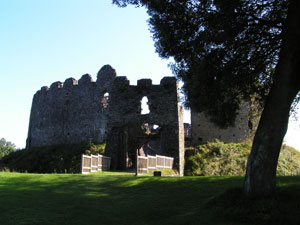 Restormel Castle is on a spur overlooking the River Fowey.
Restormel Castle is on a spur overlooking the River Fowey.
The Norman 'ringwork and bailey' castle was rebuilt in the late 13th century as a prestigious residence for Edmund, Earl of Cornwall.
After Edmund, it was only lived in occasionally. It was visited by the Black Prince and later fell into disrepair. The splendid deer park was ‘disparked’ by Henry VIII.
The castle was held briefly by the Parliamentarians in 1644, until it was captured by Grenville for the Royalists. The views from the ramparts are magnificent.
Information:
- managed by English Heritage
- car parking
- toilets
- snack kiosk
The Medieval Bridge
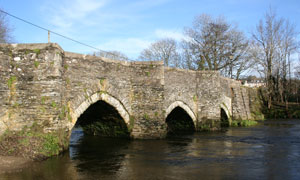 The Medieval Bridge stands at the site of the original crossing of the River Fowey.
The Medieval Bridge stands at the site of the original crossing of the River Fowey.
The river was first bridged by the Normans. The bridge was rebuilt in the 13th-14th centuries and has been repaired and kept in use ever since.
It has been the scene of many notable and emotional occasions, including the arrival of the Black Prince and his retinue to hold Court at Restormel Castle in 1354, and the dispatch of the defeated Parliamentary army by the angry citizens in 1644.
The foundations of four western arches are buried under North Street. The eastern arches were added as the river changed course.
Lostwithiel Museum
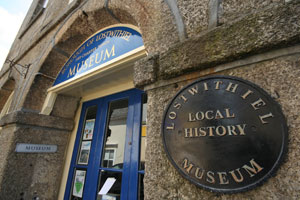
Visit Lostwithiel Museum website
The Museum is housed in the Georgian Corn Exchange and the adjoining, older, Town Gaol. It has an interesting collection of exhibits, given by local people.
The reference section contains parish records, directories and information relating to the town's history. Photographs depict the social history of the town since the early days of photography.
The Museum publishes a local history journal twice times a year, and sells various booklets of local interest.
Information:
- free admission
- disabled access
- opens for the season from early April. Check their website for current opening times
- 16 Fore Street, Lostwithiel, PL22 0AS
- Lostwithiel Museum website
Duchy Palace
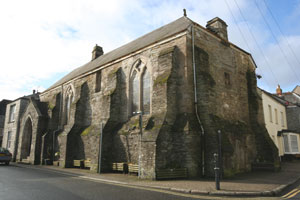 The Duchy Palace originally reached along the quay as far as the cobbled archway at the end of South Street. All Cornish affairs and the tin industry were controlled from here, including the Courts, Treasury, Maritime offices, the Stannary Parliament, smelting, coinage and assaying of tin and the stannary prison.
The Duchy Palace originally reached along the quay as far as the cobbled archway at the end of South Street. All Cornish affairs and the tin industry were controlled from here, including the Courts, Treasury, Maritime offices, the Stannary Parliament, smelting, coinage and assaying of tin and the stannary prison.
The complex was badly damaged by Parliamentary soldiers during the Siege of Lostwithiel in 1644. The Convocation Hall at the corner of Quay Street is the best preserved part of the complex and carries the emblem of the Black Prince (the first Duke of Cornwall) at the apex of the northern gable.
Today the Duchy Palace is owned by the Prince's Regeneration Trust who undertook significant conservation and renovation to the building.
St Bartholomew's Church
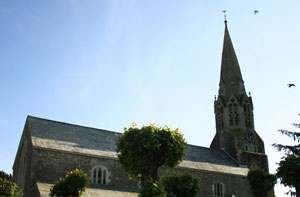 The church dedicated in honour of St Bartholomew, the patron saint of tanners, was founded in the 12th century.
The church dedicated in honour of St Bartholomew, the patron saint of tanners, was founded in the 12th century.
The square tower was added to the church in the 13th century.
The church was largely rebuilt in the 14th century. The east window and the octagonal lantern and spire atop the tower date from then. The spire has been replaced more than once.
The church was desecrated during the Civil War, when it was used to stable horses: it is said that one was christened 'Charles' by Parliamentary soldiers.
Other buildings to look out for
Taprell House was possibly a medieval guildhall developed into a dwelling at the end of the 16th century. It was the home of the Mayor during the Siege of Lostwithiel. The building is now shared by the Library and the Methodist Church.
Edgcumbe House: A Georgian extension to Taprell House was built by Lord Edgcumbe in the 1740s as his town house. A dower house was built next door for the Dowager Lady Edgcumbe.
The Grammar School, built in 1781, also served as a Market Hall and Assembly Rooms. Only the facade remains: in 1981, flats for the elderly were built in its place.
The Guildhall, above the museum, is now the Town Council Chamber: it can be opened by arrangement.
The Lime Kilns provided fertilizer for local farmers until the early 20th century.
The Cornwall Railway Carriage Works: Designed by I. K. Brunel, these buildings have been converted into housing and office accommodation.
Coulson Park: The riverside park and Nature Reserve, to the south of the town, provides tranquil surroundings for walking, fishing and observing wild life.
Words by Barbara Fraser from the Heritage Trail brochure © Lostwithiel Forum. Images by Mat Connolley and Cathy Connolley.